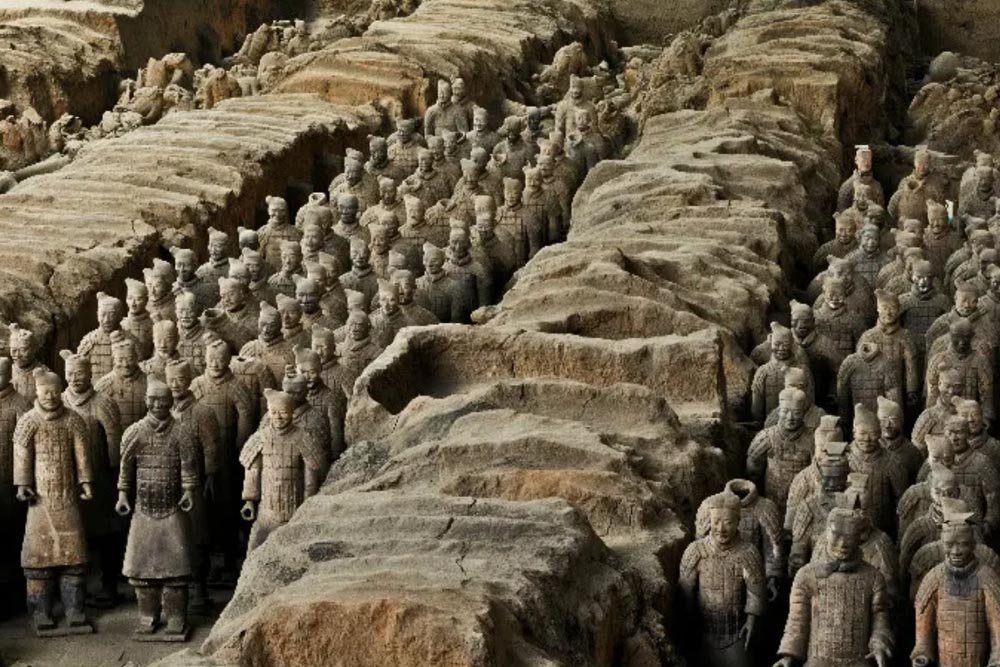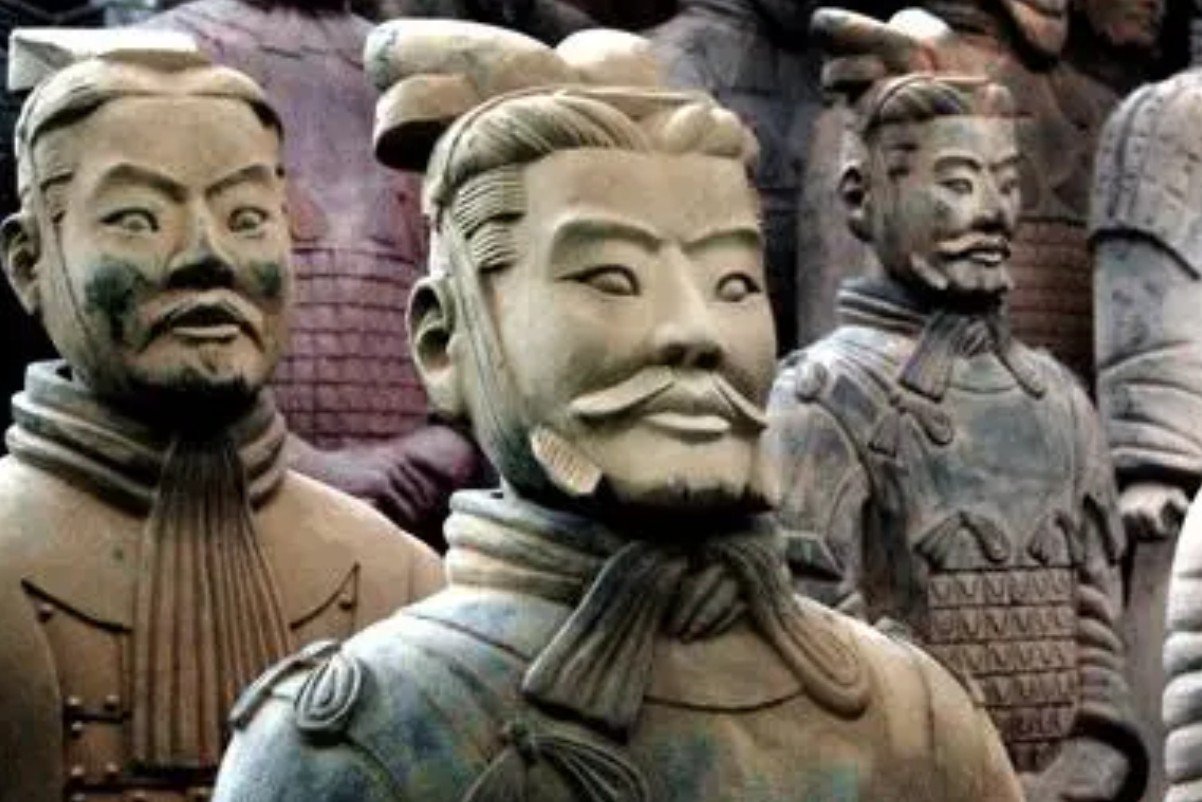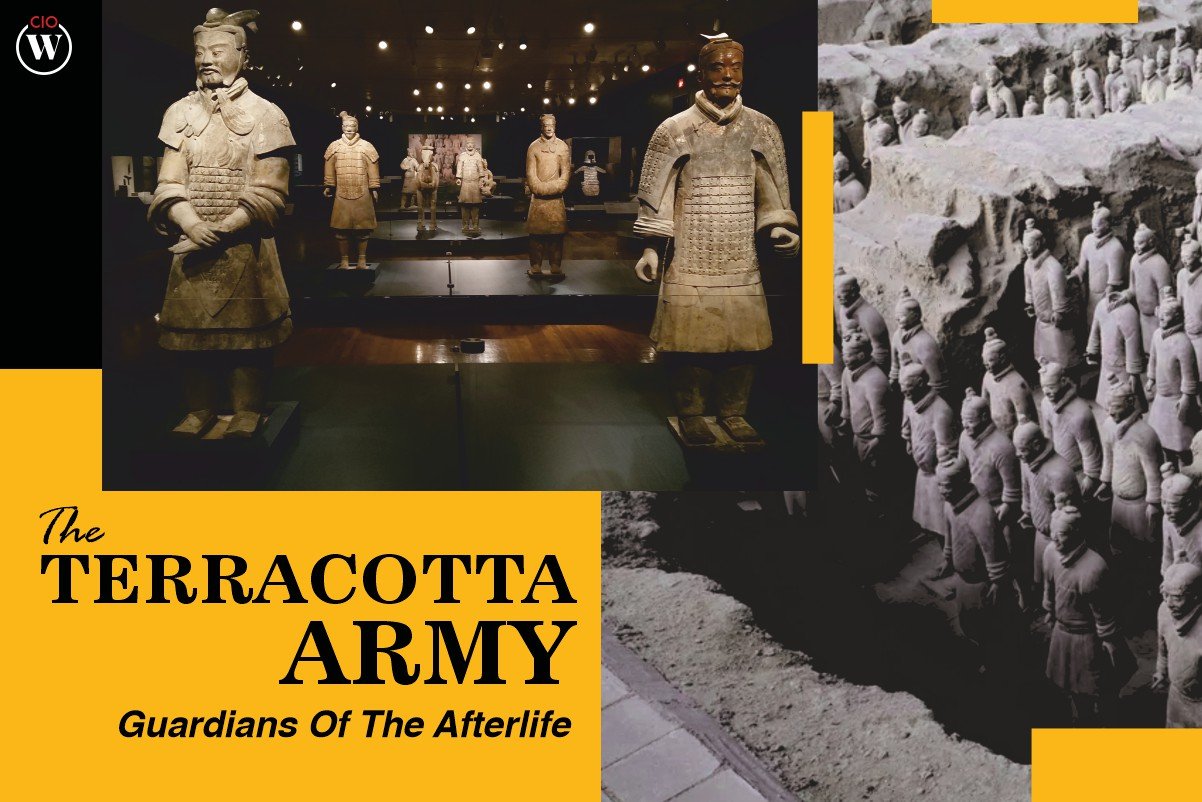The Terracotta Army, an archaeological wonder nestled in the heart of China, stands as an awe-inspiring testament to the craftsmanship, military might, and spiritual beliefs of ancient Chinese civilization. Discovered by farmers in 1974 in the Shaanxi province, near the city of Xi’an, this subterranean army has captivated the world with its sheer scale, intricate details, and the mysteries that shroud its creation. In this article, we will be discussing everything in detail about the Terracotta army.
What is the Terracotta Army?
The Terracotta Army is the buried army of an Ancient Chinese Emperor Qin Shi Huang. The sculptures of this army were built and buried over two thousand years ago in the city of Xian and consisted of foot soldiers, horses, and chariot warriors.
Each of these Terracotta warriors was made of clay. These sculptures were around two meters tall, the commanders of the soldiers being the tallest. The sculptures are detailed and each sculpture is different, with each soldier carrying daggers, swords, spears, axes, etc.
The Discovery: A Farmer’s Unearthly Encounter
In the spring of 1974, a group of farmers digging a well near Mount Li stumbled upon one of the most remarkable archaeological finds in history. Unbeknownst to them, beneath the earth lay an entire army of life-sized terracotta soldiers, horses, and chariots. The accidental discovery would unravel the secrets of an ancient mausoleum constructed for China’s first Emperor, Qin Shi Huang.
Qin Shi Huang: A Visionary Emperor
To understand the significance of the Terracotta Army, one must delve into the life and ambitions of Emperor Qin Shi Huang. Ascending to the throne of the Qin State at the age of 13, he became the first Emperor of a unified China in 221 BCE after conquering the six other warring states. With a vision to rule for eternity, Qin Shi Huang initiated the construction of a colossal mausoleum complex that would accompany him into the afterlife.
The Immortal Guard: Crafting the Terracotta Army
Qin Shi Huang’s quest for immortality was reflected in the construction of his mausoleum, and at its heart stood the Terracotta Army. Crafted to perfection, each soldier possesses unique facial features, hairstyles, and uniforms, showcasing the incredible attention to detail of the artisans. Archaeologists estimate that around 8,000 soldiers, 130 chariots, and 670 horses make up the vast army, though the full extent of the mausoleum remains unexplored.

Rank and File: Understanding the Army’s Organization
The Terracotta Army is not just a random assortment of soldiers but a meticulously organized military force. Soldiers are arranged in battle formation, with infantry, cavalry, and charioteers strategically positioned. The soldiers also vary in height, reflecting the hierarchical structure of the ancient Chinese military.
Guardians of the Emperor: The Purpose Unveiled
The primary purpose of the Terracotta Army was to safeguard Qin Shi Huang in the afterlife. The belief in an afterlife, mirroring the earthly realm, was central to ancient Chinese cosmology. The emperor’s desire to maintain the order and protection he enjoyed in life transcended death, culminating in the creation of this formidable terracotta force.
Puzzling Mysteries: Unearthed Secrets
While the Terracotta Army has provided unparalleled insights into ancient Chinese history, it also raises intriguing questions. The identity of the artisans, the methods used for construction, and the yet-to-be-discovered segments of the mausoleum continue to puzzle archaeologists and historians.
The Unfinished Business: Unexplored Regions
A significant portion of the mausoleum, including the emperor’s tomb itself, remains untouched. Fears of damaging delicate artifacts and the anticipation of advanced technologies for future exploration have led authorities to preserve certain areas. As technology evolves, the remaining mysteries beneath Mount Li may yet be unveiled.
The Colorful Past: Originally Painted Soldiers
Contrary to their current appearance, the Terracotta Army soldiers were once adorned with vibrant colors. Exposure to air and light has caused the original paint to fade, leaving behind the iconic terracotta hue. Advanced techniques are being employed to study and recreate the original painted appearance of these ancient warriors.
Preserving the Past: The Mausoleum Site
The mausoleum site surrounding the Terracotta Army is a UNESCO World Heritage Site, attesting to its global significance. Conservation efforts are ongoing to protect the delicate artifacts from environmental factors, ensuring that future generations can marvel at the craftsmanship and cultural richness of ancient China.
The Cultural Impact: A Global Phenomenon

The Terracotta Army’s global impact extends beyond its archaeological and historical significance. It has become a symbol of China’s rich cultural heritage, attracting millions of visitors annually. The site’s influence extends to popular culture, with replicas and references appearing in films, documentaries, and various forms of art.
Conclusion: An Enduring Legacy
The Terracotta Army, a silent testament to an emperor’s quest for eternal rule, continues to captivate the world with its scale, artistry, and the enigma that surrounds its creation. As archaeologists uncover more secrets and technologies advance, the mysteries of the Terracotta Army are sure to deepen, ensuring that its allure remains timeless.
In the heart of China, beneath the ground near Xi’an, an army of terracotta soldiers stands frozen in time, a testament to the grandeur of an ancient civilization and the vision of an emperor who sought immortality. The Terracotta Army, with its silent ranks and unyielding gaze, beckons us to contemplate the mysteries of the past and marvel at the enduring legacy of those who once walked the earth and now guard the afterlife.
Top 10 Facts about the Terracotta Warriors
- Each Warrior has unique facial features
- All of them participated in the first emperor’s search for immortality
- It’s not just soldiers. There was also a pit full of stone armor and several pits full of horse skeletons.
- The figures were an early feat of mass-production
- The warriors were painted
- The warriors carried real weapons
- The First Emperor’s tomb has never been opened
- There were no historical records of them existing
- More than 2,000 warriors and horses have been excavated from three different burial pits with an estimated 6,000 still buried underground
- They were discovered completely by accident

Significance:
The Terracotta Army shows the glorious lifetime of Ancient Chinese Emperor Qin Shi Huang. During Qin Shi Huang’s reign from 246 to 210 BC, he made great achievements like, unifying the separate vassal states, commanding the construction of the Great Wall of China (now a popular tourist spot) to defend against nomads, standardizing the measurement units and currencies. Standing in front of the Terracotta Warriors, the vivid scene of the first emperor of China and his army conquering other states will come into your mind easily.
More than 40,000 pieces of bronze weapons have been unearthed in the Terracotta Warriors pits, most of which are copper-plated. Besides, there are many swords, daggers, crossbows, arrowheads, billhooks, spears, halberds, spears, and axes.
All the weapons were well manufactured. The surfaces of the swords had undergone anti-oxidation treatment, thus having good properties of anti-corrosion and anti-rust. Though having been buried underground for more than 2,200 years, the blades still glitter and remain sharp. These fine weapons prove that the metallurgical techniques of China had already reached an advanced level in the Qin Dynasty, a miracle in the history of metallurgy.










